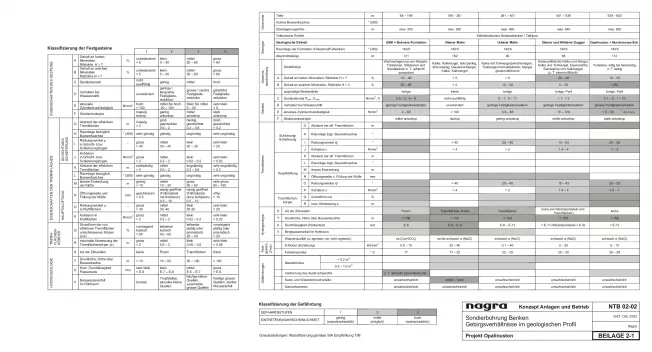
Technischer Bericht NTB 02-02
Projekt OpalinustonKonzept für die Anlage und den Betrieb eines geologischen Tiefenlagers – Entsorgungsnachweis für abgebrannte Brennelemente, verglaste hochaktive sowie langlebige mittelaktive Abfälle
The management of spent fuel (SF), vitrified high-level waste (HLW) and long-lived intermediate- level waste (TRU) principally from reprocessing is based on the concept of deep geological disposal, i.e. long-term isolation of the waste in suitable, deep-lying rock formations. The first project studies carried out by Nagra in this connection date back more than 20 years (Nagra 1980) and looked at the option of disposal in crystalline basement rock and clay. The disposal strategy developed by Nagra over the years ties in closely with the concept of "monitored, longterm geological disposal" as formulated in the most recent requirements of the authorities (EKRA 2000, KEG 2001)
This report forms part of the series produced for the Entsorgungsnachweis Project, which also includes a geological synthesis report on the region of the Zürcher Weinland (Nagra 2002a) and a safety assessment report (Nagra 2002b). The purpose of the Project is to demonstrate the feasibility of disposing of SF/HLW/TRU in Northern Switzerland.
The aim of this report is to investigate the engineering feasibility of constructing a repository for SF/HLW/TRU in the Opalinus Clay of the Zürcher Weinland and to provide project-specific input for the long-term safety assessment. Therefore, a concept for the facilities and operation of the repository was elaborated. The individual structural elements and components for which the feasibility demonstration was performed are part of a modular system, which is brought together to form a stand-alone project, presented in this report as the Reference Project.
This Reference Project is the end-result of the procedure summarised below, which consists of the following steps:
- Outlining a general procedure for handling and emplacing radioactive waste, including engineered barriers and facility design based on specific boundary conditions and requirements.
- Approximate design of transport and handling equipment and specification of the clearance profiles for the different underground structures.
- Determining the stress on key drift and tunnel cross-sections and preliminary design of rock support measures; consideration of construction procedures.
- Reviewing operational safety, ventilation and consideration of retrievability; definition of the Reference Project drawing on experience from other construction projects; investigation of closure of the facility.
In order to test the flexibility of the system, "what-if" scenarios in the form of possible alternative solutions or alternative measures have been discussed on a case-specific basis. As a result of the work that has been performed, the following conclusion can be drawn:
A deep geological repository in the Opalinus Clay of the Zürcher Weinland for spent fuel from the operation of the Swiss nuclear power plants and for vitrified high-level and long-lived intermediate-level waste mainly from reprocessing can be constructed and operated and can be closed within a few years using currently available technology and in accordance with legally prescribed safety standards. Societal requirements relating to monitoring and control, as formulated in the draft of the new Nuclear Energy Law of 2001, are fulfilled. The retrievability of emplaced waste is also assured. Spatial reserves exist and the concept for facilities and operation offers a high degree of flexibility for the continuation of the project.
